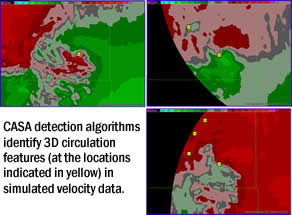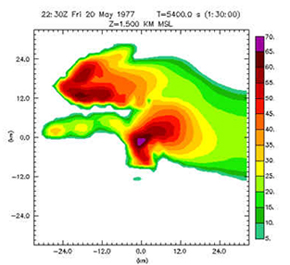Predicting
The goal of the Predicting Research Thrust was to develop meteorological algorithms that process the new and finer resolution data generated by DCAS networks and thus enable more accurate forecasts of weather events, meeting a wide range of end user needs.
The Predicting thrust developed new hazard-detection algorithms, data analysis and assimilation systems, and numerical forecast models that adapt dynamically and predict weather accurately several hours ahead of evolving storms. Our research allowed us to detect and predict (both statistically and dynamically) hazardous local weather on time scales ranging from a few minutes to several hours.
Tornado Detection Algorithms
 The ability of algorithms to accurately identify hazardous weather features in real-time is critical to developing a reliable and automated DCAS network. Unique to CASA is that the radars will capture very fine scale features that evolve rapidly in time. We have adapted various tornado and mesocyclone detection algorithms originally developed for NEXRAD radars to suit the characteristics of CASA radars. One of them is the automated tornado detection algorithm using a linear least squares derivative (LLSD) technique adapted for multiple Doppler radars within the Warning Decision Support System Integrated Information analysis and display framework. Further, we are developing techniques for identifying tornadoes using Doppler spectra wavelet analysis applied to Doppler moment data, and based on high-resolution assimilated, gridded data sets combining all available sources of observations. These new techniques hold the promise of more accurately locating tornadoes and distinguishing them from non-tornadic columnar vortices. The ability of algorithms to accurately identify hazardous weather features in real-time is critical to developing a reliable and automated DCAS network. Unique to CASA is that the radars will capture very fine scale features that evolve rapidly in time. We have adapted various tornado and mesocyclone detection algorithms originally developed for NEXRAD radars to suit the characteristics of CASA radars. One of them is the automated tornado detection algorithm using a linear least squares derivative (LLSD) technique adapted for multiple Doppler radars within the Warning Decision Support System Integrated Information analysis and display framework. Further, we are developing techniques for identifying tornadoes using Doppler spectra wavelet analysis applied to Doppler moment data, and based on high-resolution assimilated, gridded data sets combining all available sources of observations. These new techniques hold the promise of more accurately locating tornadoes and distinguishing them from non-tornadic columnar vortices.
Data Assimilation and Prediction
 One critical barrier preventing development of a rapid-response DCAS system is the current uncertainty associated with existing data assimilation techniques for rapidly-updating and streaming observations. Because Doppler radars observe only reflectivity, the radial component of velocity and its variance, inversion methods must be applied to retrieve unobserved quantities in a manner consistent with available observations and associated dynamic model constraints. One critical barrier preventing development of a rapid-response DCAS system is the current uncertainty associated with existing data assimilation techniques for rapidly-updating and streaming observations. Because Doppler radars observe only reflectivity, the radial component of velocity and its variance, inversion methods must be applied to retrieve unobserved quantities in a manner consistent with available observations and associated dynamic model constraints.
We have designed an ensemble Kalman filter (EnKF) framework for assimilating DCAS data into numerical forecast models, and with it are able to retrieve atmosphere variables not directly observed by radar. The EnKF system also produces dynamically consistent gridded analyses that are used in grid-based detection algorithms. The EnKF method is also ideally suited to handling streaming data such as that produced by the Oklahoma test bed radar system, and provides an ensemble of initial conditions that can be used to initialize probabilistic ensemble forecasts. In addition, the ensemble-based assimilation framework provides a basis for estimating the impact of various scanning configurations on the future forecast error variance which is a practical measure of forecast quality. This approach allows the optimal adaptive sampling for NWP to be determined.
Adaptive Sampling Strategies
As CASA shifts towards using solid state radars, strategies for optimally sampling the atmosphere when beam scanning times are not limited by antenna inertia become increasingly important. Several research projects explored sampling techniques that optimize information content while minimizing the use of available resources to fulfill competing end user needs and system constraints. Utilizing a variety of analytic flow fields, including solutions to the nonlinear Navier-Stokes equations, we have determined the optimal time resolution needed for dual-Doppler analysis of tornadic vortices under a variety of physical circumstances. The minimum acceptable sampling rates depend, nonlinearly, upon vortex size and pattern translation speed. Azimuthal over-sampling is found to greatly improve the quality of the retrieved wind field in the context of variational analysis. We used the Shannon information content as a metric for designing sampling strategies that extract the maximum amount of relevant information from the atmosphere while minimizing the use of available resources.
Dynamics of Tornadogenesis
 We completed the world's highest resolution simulation of a tornado and its parent supercell storm. Output from this experiment was used to test our detection algorithms, adaptive sampling strategies, and emulator and data assimilation activities described above. Further, this simulation has been combined with other simulations to study tornadogenesis in an attempt to identify those features and processes - and their physical linkages and spatio-temporal relationships - that can be used in developing tornado anticipation algorithms. A systematic study has also been performed that demonstrates a tremendous sensitivity of tornadogenesis to the often arbitrarily assumed drop-size distribution (DSD) parameters in the model microphysics, pointing to the need for improving model microphysics. This problem is closely linked to the assimilation of radar reflectivity and other dual-polarization parameters, to attenuation correction, and to QPF and QPE. Several advanced microphysics schemes, including one that predicts three moments of the DSDs, are being implemented in the ARPS, for use by various CASA applications. Read the article or view the Supercell Thunderstorm Simulation. (This file is very large and will take several minutes to open.) We completed the world's highest resolution simulation of a tornado and its parent supercell storm. Output from this experiment was used to test our detection algorithms, adaptive sampling strategies, and emulator and data assimilation activities described above. Further, this simulation has been combined with other simulations to study tornadogenesis in an attempt to identify those features and processes - and their physical linkages and spatio-temporal relationships - that can be used in developing tornado anticipation algorithms. A systematic study has also been performed that demonstrates a tremendous sensitivity of tornadogenesis to the often arbitrarily assumed drop-size distribution (DSD) parameters in the model microphysics, pointing to the need for improving model microphysics. This problem is closely linked to the assimilation of radar reflectivity and other dual-polarization parameters, to attenuation correction, and to QPF and QPE. Several advanced microphysics schemes, including one that predicts three moments of the DSDs, are being implemented in the ARPS, for use by various CASA applications. Read the article or view the Supercell Thunderstorm Simulation. (This file is very large and will take several minutes to open.)
|